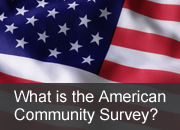
Young adults today, often called the millennial generation, are more likely to be foreign born and speak a language other than English at home, compared with young adults in 1980, according to the U.S. Census Bureau’s latest statistics from the American Community Survey released today.
“Many of the differences between generations examined within these latest data reflect long-term demographic and societal changes,” said Jonathan Vespa, a Census Bureau demographer. “Three decades of decennial census statistics combined with the latest American Community Survey statistics give us a unique view of how — and where — our nation is changing. In this case, we can look at the changing characteristics of young adults over the last few decades.”
Five years of data collected between 2009 and 2013 provide statistics on more than 40 economic, housing and social topics, such as commuting, educational attainment and home value. As the nation’s largest ongoing household survey, the American Community Survey produces statistics at all levels of geography, down to the block group level. Today, for the first time users can access block group level statistics on the census.gov tool rather than via a separate FTP site.
Highlighting some of the topics available from the American Community Survey, the Census Bureau released “Young Adults: Then and Now,” a new edition of the interactive mapping tool Census Explorer. The tool illustrates characteristics of the young adult population (age 18-34) across the decades using data from the 1980, 1990 and 2000 Censuses and the 2009-2013 American Community Survey. The American Community Survey, which is a part of the decennial census, replaced the “long form” questionnaire soon after the 2000 Census.
Comparing Generations
The 73 million young adults currently 18 to 34 years old, often referred to as millennials, comprised the largest such population in the last three decades. Nonetheless, their share of the population is actually smaller today than in 1980, when the young adult population included the baby boomers born between1946 and 1964. The baby boom is distinguished by a dramatic increase in birth rates following World War II and comprises one of the largest generations in U.S. history.
In 1980, 30 percent of the population was age 18 to 34, compared with 23 percent today.
The percentage of young adults today who are foreign born has more than doubled since 1980 (15 percent versus 6 percent).
All states have higher proportions of foreign-born young adults than 30 years ago.
The increase was larger in the West and Northeast, where 21 percent and 18 percent, respectively, are now foreign born, compared with 12 percent and 8 percent 30 years ago.
Only 9 percent of young adults in the Midwest and 14 percent in the South are foreign born, up from 3 and 4 percent, respectively, in 1980.
One in four young adults, or 17.9 million, speaks a language other than English at home. That proportion is higher still in New York, New Jersey, Texas, New Mexico and Nevada (where it is about one in three) but is highest in California (where it is about one in two).
More millennials are living in poverty today, and they have lower rates of employment, compared with their counterparts in 1980:
One in five young adults lives in poverty (13.5 million people), up from one in seven (8.4 million people) in 1980.
Today, 65 percent of young adults are employed, down from 69 percent in 1980.
Prior generations of young adults were more likely to have ever served in the armed services: 9 percent were veterans in 1980, compared with 2 percent today.
Millennials are more educated than young adults in 1980:
22 percent have a college degree, up from 16 percent in 1980. States with the largest share of young college graduates are in the Northeast, including Massachusetts, New York and New Jersey.
Unlike in prior generations, the majority of millennials have never been married, reflecting continued delays in getting married:
Only about three in 10 young adults have ever been married, down from six in 10 in 1980.
The state with the highest share of married young adults is Utah (51 percent); the lowest is Rhode Island (25 percent).
Some things have not changed:
Young adults continue to rely on a car to get to work: about eight in 10 drive to work, which is largely unchanged compared with 1980. Alabama has the highest share (95 percent); New York has the lowest (53 percent).